|
Books Should Be Free Loyal Books Free Public Domain Audiobooks & eBook Downloads |
|
|
Books Should Be Free Loyal Books Free Public Domain Audiobooks & eBook Downloads |
|
Science Fiction |
|---|
|
Book type:
Sort by:
View by:
|
By: Lester Del Rey (1915-1993) | |
|---|---|
 Badge of Infamy
Badge of Infamy
Shifting between Earth and Mars, Badge of Infamy focuses on the gripping tale of a former doctor who becomes a pariah due to being temporarily governed by emotion and compassion, rather than complying with the highly regarded rules established by the Medical Lobby. Furthermore, the novel covers numerous topics including justice, brutality, betrayal, ethics, political control, and lobbying. Set in the year 2100, the novel begins with the introduction of its protagonist, Daniel Feldman, an ethical man, who makes the terrible mistake of going against the fixed medical protocol and performing surgery to save the life of a friend... | |
By: Lester del Rey | |
|---|---|
 Victory
Victory
Lester del Rey (1915 – 1993) was a Golden Age science fiction author and editor closely connected to John W. Campbell Jr. and Astounding Science Fiction magazine. He also founded Del Rey Books, a popular publishing label he edited with his wife Judy-Lynn. Victory is the story of an undefended Earth in a warring galaxy. It appeared in the August 1955 issue of Astounding Science Fiction. | |
 The Sky Is Falling
The Sky Is Falling
After dying in a terrible accident at a building site, Dave Hanson finds himself being brought back to life in a world where magic is real, and where the sky is breaking apart and falling. And he is expected to put it back together again. Will he be able to save this strange world, and his own new life? | |
 Let'em Breathe Space
Let'em Breathe Space
The old space freighter Wahoo is all Dr. Pietro can afford for his expedition to the rings of Saturn. Although built for a crew of 6 the good doctor crams 19 people into the Wahoo, and after 5 months they are really getting on each other’s nerves. Then someone starts killing people and poisoning the air giving plants in the hydroponics bay. Can our hero Paul Tremaine find the killer before he suffocates? Perhaps you should hold your breath. – Let’em Breathe Space was first published in the July 1953 edition of Space Science Fiction magazine. | |
 Police Your Planet
Police Your Planet
Bruce Gordon looked at his ticket, grimaced at the ONE WAY stamped on it, then tore it into bits and let the pieces scatter over the floor. He counted them as they fell; thirty pieces in all, one for each year of his life. Little ones for the two years he'd wasted as a cop. Shreds for the four years as a kid in the ring before that--he'd never made the top. Bigger bits for two years also wasted in trying his hand at professional gambling; and the six final pieces that spelled his rise from special reporter helping out with a police shake-up coverage, through a regular leg-man turning up rackets, and on up like a meteor until... | |
 3 Science Fiction Stories by Lester del Ray
3 Science Fiction Stories by Lester del Ray
The quirky mind of famous SF writer Lester del Ray gives us three wonderful tales ranging from zombies , time travel and eternal life . Listen and enjoy. | |
By: Linton Davies | |
|---|---|
 War-Lords of the Moon
War-Lords of the Moon
Bruce Ross, on the Earth-Moon run, asked a simple question, "How are the stars behaving, Harry?" But Harrell Moore could only stare at him in horror. For the stars had run amok—cosmic engines of destruction in the hands of the twisted genius of the Moon! A rip-snortin space shoot-em-up from 1939 with space ships, an evil genius who follows his horoscope and plans to rule everyone, ray guns, death beams and a diaphanously clad beautiful moon princesses in love with the hero. - Summary by the author and phil chenevert | |
By: Lloyd Eshbach (1910-2003) | |
|---|---|
 The Gray Plague
The Gray Plague
End of the world sci-fi tale borrows heavily from H.G. Wells' WOTW and In The Days of the Comet -- looks like fun ! | |
By: Louis Pope Gratacap (1851-1917) | |
|---|---|
 Evacuation of England: The Twist in the Gulf Stream
Evacuation of England: The Twist in the Gulf Stream
This book is ostensibly about a theoretical catastrophic geologic event. It turns into a meditation on what it means to be an English person, and at the end, includes a ringing defense of America. | |
By: Lucian of Samosata | |
|---|---|
 Lucian's True History
Lucian's True History
One of the earliest works of science-fiction . It has space travel , lunar civilization, and aliens, along with more fantasy elements, such as the afterlife and Greek gods. A satire on contemporary tall tales. - Summary by Terry Kroenung | |
By: Mack Reynolds (1917-1983) | |
|---|---|
 Mercenary
Mercenary
Every status-quo-caste society in history has left open two roads to rise above your caste: The Priest and The Warrior. But in a society of TV and tranquilizers--the Warrior acquires a strange new meaning... (Introduction from the Gutenberg text) | |
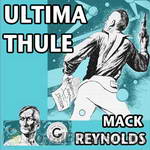 Ultima Thule
Ultima Thule
Ronny Bronston has dreamed all his life of getting a United Planets job that would take him off-world. He finally gets the opportunity when he is given a provisional assignment with Bureau of Investigation, Section G. But will he be able to complete his assignment and find the elusive Tommy Paine? | |
 5 SF stories by Mack Reynolds
5 SF stories by Mack Reynolds
Five Science Fiction stories from the strange mind of Mack Reynolds. Always innovative and interesting, these were published in the early science fiction and fantasy magazines of the 1940's and 50's. - Summary by phil chenevert | |
By: Manly Wade Wellman (1903-1986) | |
|---|---|
 Venus Enslaved
Venus Enslaved
A rip-snorting, 1940s science fiction adventure from the pen of Manly Wade Wellman. What chance had the castaway Earthman and his crossbow-weaponed Amazons against the mighty Frogmasters of the Veiled Planet? Hmmm? What chance indeed? From his broad shoulders, rippling muscles fighting spirit and keen intelligence, our hero finds a way to victory and perhaps even love. Listen and enjoy. - Summary by Phil Chenevert | |
 Warrior of Two Worlds
Warrior of Two Worlds
"He was the man of two planets, drawn through the blackness of space to save a nation from ruthless invaders. He was Yandro, the Stranger of the Prophecy—and he found that he was destined to fight both sides." Another swashbuckler in space from Manly Wade Wellman. Who could ask for anything more? - Summary by the publisher and phil chenevert | |
By: Marion Zimmer Bradley | |
|---|---|
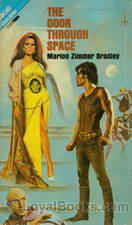 The Door Through Space
The Door Through Space
At one time Race Cargill had been the best Terran Intelligence agent on the complex and mysterious planet of Wolf. He had repeatedly imperiled his life amongst the half-human and non-human creatures of the sullen world. And he had repeatedly accomplished the fantastic missions until his name was emblazoned with glory. But that had all seemingly ended. For six long years he’d sat behind a boring desk inside the fenced-in Terran Headquarters, cut off there ever since he and a rival had scarred and ripped each other in blood-feud... | |
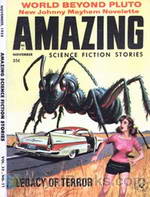 The Planet Savers
The Planet Savers
The Terran colony on the planet Darkover faces imminent destruction by a plague of the deadly Trailmen's Fever. The only hope is to develop a serum in time, but this requires the cooperation of the elusive native Trailmen, the brilliant parasitologist Dr. Jay Allison, and his split personality. (Introduction by Mark Nelson) | |
By: Mark Phillips (Randall Garrett and Laurence M. Janifer) | |
|---|---|
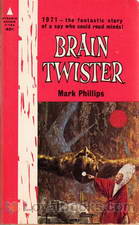 Brain Twister
Brain Twister
“Mark Phillips” is, or are, two writers: Randall Garrett and Laurence M. Janifer. Their joint pen-name, derived from their middle names (Philip and Mark), was coined soon after their original meeting, at a science-fiction convention. Both men were drunk at the time, which explains a good deal, and only one has ever sobered up. A matter for constant contention between the collaborators is which one. Originally published as That Sweet Little Old Lady, Brain Twister follows the adventures of FBI agent Kenneth J... | |
By: Mary Wollstonecraft Shelley | |
|---|---|
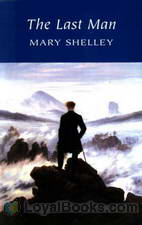 The Last Man
The Last Man
The Last Man is an early post-apocalyptic science fiction novel by Mary Shelley, which was first published in 1826. The book tells of a future world that has been ravaged by a plague. The plague gradually kills off all people. Lionel Verney, central character, son of a nobleman who gambled himself into poverty, finds himself immune after being attacked by an infected “negro,” and copes with a civilization that is gradually dying out around him. | |
 Tales and Stories
Tales and Stories
While Mary Shelley will most likely always be known for her enduring classic of mad science Frankenstein, this collection intends to show the sheer breath and quality of her writing beyond the creation for which she is most known. Many of these stories are told in an atmospheric gothic fiction vein, full of eerie old castles, strange revelations and family secrets. But we also have stories of the supernatural and even science fiction to contend with. Shelley was a true literary master and should be recognized for her contributions to literature beyond her most famous work. - Summary by Ben Tucker | |
By: Maurice Renard (1875-1939) | |
|---|---|
 New Bodies for Old
New Bodies for Old
Maurice Renard's little known but delightfully bizarre tale of mad science run amok owes much to H. G. Wells' The Island of Dr. Moreau while also forging its own path by taking Wells' plot as a starting point and pushing it to ridiculous extremes. When a young man named Nicholas goes to visit his beloved scientist uncle Dr. Lerne in a remote French chateau, he is immediately put on his guard by his uncle's strange behavior, the mysterious Germans who now work with his uncle in a secret laboratory on the premises, on the strange noises he hears in the night... | |
By: Michael Shaara (1928-1988) | |
|---|---|
 Conquest Over Time
Conquest Over Time
Pat Travis, a spacer renowned for his luck, is suddenly quite out of it. His job is to beat his competitors to sign newly-Contacted human races to commercial contracts...But what can he do when he finds he's on a planet that consults astrology for literally every major decision - and he has arrived on one of the worst-aspected days in history?Michael Shaara, later to write the Pulitzer-winning novel "The Killer Angels", wrote this story for Fantastic Universe in 1956. | |
By: Monroe K. Ruch | |
|---|---|
 Moon Destroyers
Moon Destroyers
The tremendous speed of the dive brought them so close that they could see the skeletons of wrecked ships piled up at the base of the precipice. The moon is not only the most prominent object in our heavens, but also an integral part of the earth. We are, so to speak, an astronomical unit, and we affect each other for better or for worse. We know that the gravitational attraction of the moon causes our tides, and tends to slow up the earth in her daily rotation. It has also been deemed responsible for earthquakes, causing untold suffering among earth's people. Does the moon hold other secrets? - Summary by Author | |
By: Murray Leinster (1896-1975) | |
|---|---|
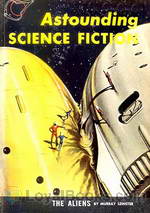 The Aliens
The Aliens
This story starts with space ships scouring the universe in an interplanetary game of tag. The humans know there are “Aliens” out there. But so do the Aliens. As each tries desperately to make the phenomenal discovery, they secretly hope that the other will not turn out to be the enemy. Humans call them “Plumies” because of the feathery plumes they inscribe on silicon-bronze tablets and cairns they have left behind on their intergalactic travels over the last thousand years. The search goes on, till one day somewhere in outer space, a Plumie ship collides with the one manned by humans... | |
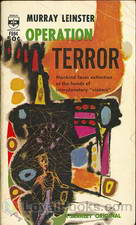 Operation Terror
Operation Terror
An unidentified space ship lands in a Colorado lake. Equipped with a paralyzing ray weapon, the creatures begin taking human prisoners. A loan land surveyor and a journalist are trapped inside the Army cordon, which is helpless against the mysterious enemy. Can they stop the aliens before it is too late? | |
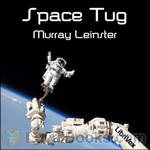 Space Tug
Space Tug
Joe Kenmore heard the airlock close with a sickening wheeze and then a clank. In desperation he turned toward Haney. “My God, we’ve been locked out!” Through the transparent domes of their space helmets, Joe could see a look of horror and disbelief pass across Haney’s face. But it was true! Joe and his crew were locked out of the Space Platform. Four thousand miles below circled the Earth. Under Joe’s feet rested the solid steel hull of his home in outer space. But without tools there was no hope of getting back inside. Joe looked at his oxygen meter. It registered thirty minutes to live. | |
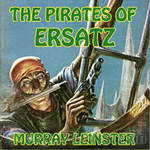 The Pirates of Ersatz
The Pirates of Ersatz
Bron is the offspring of infamous space pirates but instead of following in the family footsteps he decides to become an electronic engineer. Unfortunately, every time he tries to get out, something pulls him back in. This is a tongue-in-cheek space adventure along the lines of the Stainless Steel Rat by Harry Harrison. It was originally published in the FEB-APR issues of Astounding Science Fiction in 1959. | |
 The Mad Planet
The Mad Planet
It is 30,000 years following dramatically changed climate conditions on earth which had let massive amounts of carbon dioxide belch from the interior of the planet into the atmosphere. Over the millenia this would have quite devastating effects on life as it had once been known. Much of the human and animal population would not survive the climate change, and indeed those few humans who did survive knew nothing of all which their predecessors had learned and built. Indeed, they knew not even of their existence... | |
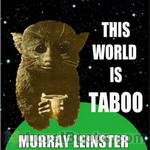 This World Is Taboo
This World Is Taboo
Calhoun is an Interstellar Medical Serviceman, and he's needed on Dara. Trouble is: Dara is forbidden. Taboo. And breaking quarantine will make Calhoun a presumed plague-carrier and subject to being shot on sight by anyone from Weald. But hey! If he did the smart thing, we wouldn't have a story!But why are men from Dara shooting at him? | |
 Talents, Incorporated
Talents, Incorporated
Bors felt as if he'd been hit over the head. This was ridiculous! He'd planned and carried out the destruction of that warship because the information of its existence and location was verified by a magnetometer.But, if he'd known how the information had been obtained--if he'd known it had been guessed at by a discharged spaceport employee, and a paranoid personality, and a man who used a hazel twig or something similar--if he'd known that, he'd never have dreamed of accepting it. He'd have dismissed it flatly! | |
 The Hate Disease
The Hate Disease
Dr. Calhoun and his pet tormal Murgatroyd work for the Interstellar Medical Service making routine public health inspections on far-flung colonial planets. When they reach Tallien Three they are greeted with a rocket attack by the Paras, a mutated form of human rapidly replacing the “normals”. The normals think it’s a pandemic of demonic possession but Calhoun has his doubts. If he can keep from turning into a Para, or being assassinated by them he just might figure this thing out. – The Hate Disease was first published in the August 1963 edition of Analog Science Fact and Fiction magazine. | |
 The Runaway Skyscraper
The Runaway Skyscraper
Arthur Chamberlain has problems. His one-man engineering firm is faltering and his pretty secretary Estelle barely notices him. But these problems are put aside when his Manhattan office building falls into the fourth dimension. Madison Square is filled with wigwams and it’s up to Arthur to engineer a way to make his building to fall back to the future. – The Runaway Skyscraper first appeared in the February 22, 1919 issue of Argosy magazine. | |
 Operation: Outer Space
Operation: Outer Space
Jed Cochrane is about to take off on man's first interstellar voyage. His mission: Make sure it's good television! (Introduction by Mark Nelson) | |
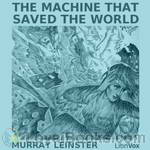 The Machine that Saved the World
The Machine that Saved the World
They were broadcasts from nowhere--sinister emanations flooding in from space--smashing any receiver that picked them up. What defense could Earth devise against science such as this? In the far future of 1972, on a secret military installation, Staff Sergeant Bellews is an expert on the latest scientific discovery: a way for ordinary machines like vacuums and lawnmowers to gather experience in their jobs, becoming error free over time. Then the strange broadcasts began to blow up transmitters everywhere. Were they from space? Enemies? the future? He didn't care until they started messin' with his machines. Then he took it personally. (summary from the first chapter and Phil Chenevert) | |
 The Ambulance Made Two Trips
The Ambulance Made Two Trips
Big Jake Connors is taking over his town through violence, inimidation and bribery but Detective Sergeant Fitzgerald can only grind his teeth in frustration. The gangsters seem to have everything going their way until the day that a little dry cleaning establishment declines their offer of 'protection' and strange things start to happen. Murray Leinster gives us another wonderful product of 'what if' from his limitless imagination to enjoy in this gem of a story. Listen and smile. | |
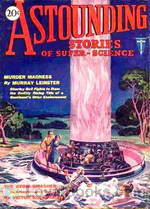 Murder Madness
Murder Madness
Murder Madness! Seven Secret Service men had completely disappeared. Another had been found a screaming, homicidal maniac, whose fingers writhed like snakes. So Bell, of the secret "Trade," plunges into South America after The Master--the mighty, unknown octopus of power whose diabolical poison threatens a continent! | |
 Space Platform
Space Platform
SPACE PLATFORM tells the exciting story of a young man helping to build this first station. With scientific accuracy and imagination Murray Leinster, one of the world's top science-fiction writers, describes the building and launching of the platform. Here is a fast-paced story of sabotage and murder directed against a project more secret and valuable than the atom bomb! | |
 Thousand Degrees Below Zero
Thousand Degrees Below Zero
The War to End All Wars has ended and the world has taken a deep breath and is trying to recover normal life in 1919. But a super Villan intent on ruling the entire world has other ideas. In his super fast helicopter he sorties out to block the major ports and rives of the world until all nations with icebergs made by his fiendishly clever devices until they admit his supremacy and kneel before his might. The might of nations are helpless before him but he does not count on our hero, a scientist specializing in low temperatures who was also a gunner in WWI... | |
 Deadly Dust
Deadly Dust
Murray Leinster does not disappoint with this gem of a story. The dust is deadly. It is slowly drifting down over the North American continent. Not ordinary dust, this dust is highly radioactive and silently deadly. Only one person sees too clearly that the USA is doomed and everyone in it unless this horrible, silent, death brining 'dust' can be stopped. And he, Doctor David Murfree, the only person to see the danger, cannot get permission from his superior to take leave from his civil servant job so that he can find the only man in America who might know what is causing this dust and perhaps even fix it. . - Summary by phil chenevert | |
By: Philip Jose Farmer (1918-2009) | |
|---|---|
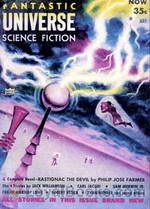 Rastignac The Devil
Rastignac The Devil
French colonists on a planet ruled by reptiles and amphibians are forced to wear living “skins” that subdue aggression and enforce vegetarianism. As children, Rastignac and his reptile friend Mapfarity force themselves to become carnivores and begin a protein fueled journey that causes Rastignac to develop a Philosophy of Violence. When a spaceship from Earth crashes in the ocean, Rastignac and company must put their philosophy to the test. - Rastignac The Devil was first published in the May 1954 issue of Fantastic Universe Magazine. | |
By: Philip José Farmer (1918-2009) | |
|---|---|
 Green Odyssey (version 2)
Green Odyssey (version 2)
A rip-roaring, pulpy and quirky space odyssey for your listening pleasure. Follow earth man Allen Green as his space ship fails and leaves him on a barbaric planet filled with other human descendants who have reverted to pre-technology existence. Naturally he is made a slave and must connive, plan, love and fight his way across 10,000 miles of danger to freedom. Full of strange beings, this planet highlights the amazing imagination of Philip Jose Farmer and his ability to make it scary and fun at the same time... | |
By: Philip K. Dick (1928-1982) | |
|---|---|
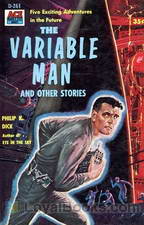 The Variable Man
The Variable Man
Predictability has come a long way. The computers of the future can tell you if you’re going to win a war before you fire a shot. Unfortunately they’re predicting perpetual standoff between the Terran and Centaurian Empires. What they need is something unpredictable, what they get is Thomas Cole, a man from the past accidently dragged forward in time. Will he fit their calculations, or is he the random variable that can break the stalemate? – The Variable Man first appeared in the September, 1953 issue of Space Science Fiction magazine. | |
 Second Variety
Second Variety
Early victories by the USSR in a global nuclear war cause the United Nations government to retreat to the moon leaving behind troops and fierce autonomous robots called “Claws”, which reproduce and redesign themselves in unmanned subterranean factories. After six bloody years of conflict the Soviets call for an urgent conference and UN Major Joseph Hendricks sets out to meet them. Along the way he will discover what the Claws have been up to, and it isn’t good… - Second Variety was first published in the May 1953 edition of Space Science Fiction Magazine. | |
 Mr. Spaceship
Mr. Spaceship
The war with the Yucks from Proxima Centauri was claimed to be a stalemate but they were really winning. The mine belts they laid seemed to propagate themselves and were slowly strangling Terran planets. How did they do that? What was their secret? The answer was baffling and the best human minds could only conclude that their ships and mines were somehow alive. So, the next desperate step was to ask "If they are using organic ships, why can't we do the same?". Thus Mr. Spaceship was conceived and carried out. But will a conscious warship do what the generals wish? Perhaps and perhaps something entirely surprising! | |
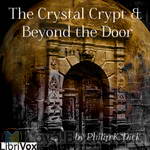 The Crystal Crypt & Beyond the Door
The Crystal Crypt & Beyond the Door
Two early science fiction stories by the wonderful craftsman, Philip K. Dick. In the Crystal Crypt, taken from the 1954 Planet Stories, the war between Mars and Terra is about to erupt and earth has only merchants and salesmen to fight; can they carry out their mission? Beyond the Door is a story that asks and answers the question: what lives beyond the door? And is it dangerous? | |
 The Defenders
The Defenders
The terrible destruction of total nuclear war between the Western and Eastern Blocks has succeeded in sterilizing the surface of the earth. No living creature can now exist there and all humans on both sides, have fled to the hives built miles below the surface where they constantly work to produce the war materials necessary to carry on the battle. For 8 years now, the actual fighting between these super powers has been conducted by robots known as Ledeys since only they can sustain the terrible levels of radiation caused by the constant bombardment... | |
 Beyond Lies the Wub & The Skull
Beyond Lies the Wub & The Skull
Two stories in the inimitable Philip Dick style. What is a Wub? A 400 pound slovenly, fat, ungainly, drooling animal that looks like a cross between a walrus and an enormous hog? Well, yes that is pretty much what he looks like and for 50 cents, a good bargain no matter how he tastes. The hungry spaceship crew expect to find out. Of course the Wub may not entirely agree but it doesn't have much to say about it. The second story, The Skull, is a skilful mesh of time travel, unscrupulous governments, prisoners, and religion. With an assassin thrown in for good measure. Enjoy! | |
 The Eyes Have It & Tony and the Beetles
The Eyes Have It & Tony and the Beetles
Aliens have invaded the earth! Horrible one celled creatures disguised as normal human beings ! Well, at least that is what it seems to the author. Yes, The Eyes Have It is a whimsical story, making gentle fun of certain writing styles, but only a topflight science-fictionist like Philip Dick , we thought, could have written this story, in just this way. Tony and the Beetles takes place far in the future when Earth's enormous colonial empire is well established but the question is, how long can it last? 10 year old Tony grows up fast when history catches up with the human race. A sobering look at human history .. and our probable future. Two very different stories but both entertaining. | |
By: Plague Ship (1912-2005) | |
|---|---|
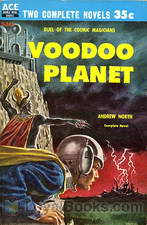 Voodoo Planet
Voodoo Planet
The sequel to Plague Ship, Voodoo Planet finds the Solar Queen banned from trade and starting her supposed quiet two-year stint as an interstellar mail carrier. But instead her crew accepts a visit to the safari planet of Khatka, where they find themselves caught in a battle between the forces of reason and the powers of Khatka’s mind-controlling wizard. | |
By: Poul Anderson (1926-2001) | |
|---|---|
 Security
Security
“Security”, tells the story of a compartmentalized government physicist ordered by secret police to complete experiments aimed at developing a new weapon. He is brought to a hidden space station and put in charge of the project but there are many questions. In a world of spies watching spies it’s sometimes hard to know what’s patriotic. -- Poul Anderson was a Golden Age Science Fiction and Fantasy author. “Security” first appeared in the magazine “Space Science Fiction” in February of 1953 | |
By: Poul William Anderson (1926-2001) | |
|---|---|
 Inside Earth
Inside Earth
This story takes place in the not so distant future. Earth has been conquered and is a subjugated planet, the much too humanoid new rulers now extract heavy taxes, control industry and reproduction and interfere in every aspect of life. Rumors of their brutality and vicious massacres increase every day. Obviously, they must be thrown out and rebellion seethes among the patriots. But on the other hand, others are not so eager to get rid of the overlords: the terrible nationalistic wars have been stopped, famine is long gone and health care is almost universally available... | |
 Snowball
Snowball
Simon's new source of power promised a new era for Mankind. But what happens to world economy when anyone can manufacture it in the kitchen oven?... Here's one answer! Summary by Realisticspeakers | |
 Out of the Iron Womb!
Out of the Iron Womb!
Behind a pale Venusian mask lay hidden the arch-humanist, the anti-tech killer ... one of those who needlessly had strewn Malone blood across the heavens from Saturn to the sun. Now—on distant Trojan asteroids—the rendezvous for death was plainly marked. This is an outstanding story from Poul Anderson, renowned as one of the greatest science fiction writers. - Summary by Author | |
 Star Ship
Star Ship
The strangest space-castaways of all! The Terrans left their great interstellar ship unmanned in a tight orbit around Khazak—descended, all of them, in a lifeboat to investigate that weird, Iron Age world—and the lifeboat cracked up! This story is Poul Anderson at his best, ride along through the galaxy and see what adventure awaits. - Summary by Paul Harvey | |
 Lord of a Thousand Suns
Lord of a Thousand Suns
A Man without a World, this 1,000,000-year-old Daryesh! Once Lord of a Thousand Suns, now condemned to rove the spaceways in alien form, searching for love, for life, for the great lost Vwyrdda. A great Poul Anderson story. - Summary by Poul Anderson | |
 Tiger by the Tail
Tiger by the Tail
The haughty, horned aliens from the planet Scotha had very well organized intentions of conquering the Terran Empire—and Captain Dominic Flandry, Terra's ace saboteur, suddenly found himself in a strategic position to louse up the works. How? Well, Achilles had a heel ... and what else could you call a Scothani? A great Poul Anderson story! - Summary by author | |
 Swordsman of Lost Terra
Swordsman of Lost Terra
Proud Kery of Broina felt like a ghost himself; shade of a madman flitting hopelessly to the citadel of Earth's disinherited ... to recapture the resonant pipes of Killorn—weapon of the gods—before they blared forth the dirge of the world. A great one from Poul Anderson! - Summary by author | |
By: Ralph Milne Farley (1887-1963) | |
|---|---|
 Earthman on Venus
Earthman on Venus
When Myles Cabot accidentally transmitted himself to the planet Venus, he found himself naked and bewildered on a mystery world where every unguarded minute might mean a horrible death. Man-eating plants, tiger-sized spiders, and dictatorial ant-men kept Myles on the run until he discovered the secret of the land—that humanity was a slave-race and that the monster ants were the real rulers of the world! But Cabot was resourceful, and when his new found love, the Kewpie-doll princess Lilla, called for help, the ant-men learned what an angry Earthman can do... | |
 Radio Planet
Radio Planet
Could you make a radio set? Don’t answer rashly. Don’t say that you have already built several. For note that we did not ask whether you could assemble a set from parts already manufactured by others, but rather whether you could build the entire set yourself—from the ground up. That means making every part you require, including the vacuum tubes, the acid in the batteries, the wires, the insulation. If you think that you could do this, let us ask you one further question. Put yourself in the place of the hero of the following story, and imagine yourself stranded amid intelligent savages who have not progressed beyond the wood age... | |
 Radio Beasts
Radio Beasts
This is the second book of a fanciful series written by Ralph Milne Farley, pen name for Roger Sherman Hoar. It is an interplanetary adventure in the style of Edgar Rice Burroughs. In the first book, "An Earthman On Venus," Myles Cabot, an electrical engineer from Earth, was accidentally transported to the planet Venus while attempting to transfer matter in a small scale experiment in his Boston laboratory. Alone and unarmed and finding himself on Poros, the local name for his new-found alien world, Cabot was swiftly captured by a race of giant intelligent ants, called Formians... | |
By: Randall Garrett (1927-1987) | |
|---|---|
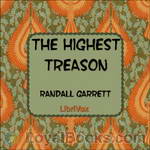 The Highest Treason
The Highest Treason
Set in a future in which humanity’s dream of total equality is fully realized and poverty in terms of material wealth has been eliminated, humanity has straight-jacketed itself into the only social system which could make this possible. Class differentiation is entirely horizontal rather than vertical and no matter what one’s chosen field, all advancement is based solely on seniority rather than ability. What is an intelligent and ambitious man to do when enslaved by a culture that forbids him from utilizing his God-given talents? If he’s a military officer in time of war, he might just decide to switch sides... | |
 A Spaceship Named McGuire
A Spaceship Named McGuire
Can a spaceship go crazy? Well, yes it can if it has a brain. And the new MG (magnetogravitic drive) experimental robot space ship does indeed have a 'brain'. Completely bewildered as to why the first six models of their supposedly perfect new ship model, the MG-YR, nicknamed the McGuire, have gone totally bonkers after activation and before they could ever be used, the company has called in the services of Daniel Oak. They suspect sabotage of course. Daniel Oak is the hard boiled private investigator with nerves of steel and a mind of the same substance... | |
 Nor Iron Bars A Cage....
Nor Iron Bars A Cage....
Iron bars do not confine a Man—only his body. There are more subtle, and more confining bindings, however....Police methods of the future will naturally use complex new technology but police will still need to deal with the same old sad human nature, that is forever doing horrible deeds. The night stick may be replaced by the hypo-gun but is prison the only solution? Listen to this speculative story from Randall Garrett bizarre mind and see. | |
 Unwise Child
Unwise Child
When a super-robot named Snookums discovers how to build his own superbombs, it becomes obvious that Earth is by no means the safest place for him to be. And so Dr. Fitzhugh, his designer, and Leda Crannon, a child psychologist acting as Snookums’ nursemaid, agree to set up Operation Brainchild, a plan to transport the robot to a far distant planet. But the space ship becomes the scene of some frightening events--the medical officer is murdered, and Snookums appears to be the culprit… | |
 That Sweet Little Old Lady
That Sweet Little Old Lady
Randall Garrett had this story first published in Astounding Science Fiction September and October of 1959. His twisted sense of humor and gift for the bizarre situation with believable characters shines here. In the not too distant future, Ken Malone, young but promising FBI agent , is given the most important and difficult assignment of his career: find a spy who is stealing information from the Ultra Top Absolute Secret project to develop a non-rocket space ship at Yucca Flats Labs in Nevada. But this is not a normal spy, this spy laughs at the FBI and all attempts to find him or her because they use an unknown new method to steal the information directly from the minds of the scientists. | |
 Anything You Can Do!
Anything You Can Do!
An alien crash lands on Earth, and for ten years terrorizes the planet, hiding, periodically killing and eating people and stealing materials for some unknown purpose. The only hope is Bart Stanton, a medically-engineered superman, designed for the sole purpose of confronting the “Nipe”. | |
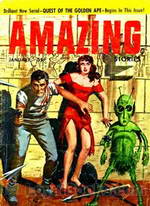 Quest of the Golden Ape
Quest of the Golden Ape
How could this man awaken with no past—no childhood—no recollection except of a vague world of terror from which his mother cried out for vengeance and the slaughter of his own people stood as a monument of infamy? Image is an illustration from the Gutenberg text. | |
 His Master's Voice
His Master's Voice
This is a follow up story to Randal Garrett's original story, A Spaceship Named McGyer. The intrepid protagonist, now that he has become the completely unintended and unwilling master of the robot spaceship McGyer, is called in by the owners, very reluctantly. to see if he can help their experts fix the problem. Since he is the only human McGyer will listen to they must have him there to get the ship to comply with any request at all. But there are rival corporations that wish the ship and the project, robot spaceships, to fail so he is indeed in great danger... | |
By: Ray Bradbury (1920-2012) | |
|---|---|
 Pillar of Fire
Pillar of Fire
"We cannot tell you what kind of a story this is. We simply cannot present it as we present other stories. It is too tremendous for that. We are very glad—and proud—to share it with you." - Summary by Planet Stories, Summer 1948 | |
 Creatures That Time Forgot
Creatures That Time Forgot
Mad, impossible world! Sun-blasted by day, cold-wracked by night—and life condensed by radiation into eight days! Sim eyed the Ship—if he only dared reach it and escape! ... but it was more than half an hour distant—the limit of life itself! - Summary by Planet Stories, Fall 1946 | |
By: Ray Cummings (1887-1957) | |
|---|---|
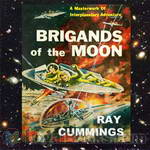 Brigands of the Moon
Brigands of the Moon
Gregg Haljan was aware that there was a certain danger in having the giant spaceship Planetara stop off at the moon to pick up Grantline’s special cargo of moon ore. For that rare metal — invaluable in keeping Earth’s technology running — was the target of many greedy eyes. But nevertheless he hadn’t figured on the special twist the clever Martian brigands would use. So when he found both the ship and himself suddenly in their hands, he knew that there was only one way in which he could hope to save that cargo and his own secret — that would be by turning space-pirate himself and paying the Brigands of the Moon back in their own interplanetary coin. (From the Gutenberg e-text) | |
 The Girl in the Golden Atom
The Girl in the Golden Atom
While examining a golden ring under a microscope, a chemist discovers a sub-atomic world. During his examination of this world he sees a beautiful young girl. After developing chemicals that will allow him to either shrink or grow larger in size, he and three friends journey to this small world. | |
 The World Beyond
The World Beyond
Lee Anthony finds himself and two of his friends kidnapped and taken on a strange voyage. | |
 Fire People
Fire People
In effect Professor Newland declared that the curious astronomical phenomena of the previous November--the new "stars" observed, the two meteors that had fallen with their red and green light-fire--were all evidence of the existence of intelligent life on the planet Mercury. (An excerpt from chapter 1. ) | |
 Wandl the Invader
Wandl the Invader
There were nine major planets in the Solar System and it was within their boundaries that man first set up interplanetary commerce and began trading with the ancient Martian civilization. And then they discovered a tenth planet--a maverick! This tenth world, if it had an orbit, had a strange one, for it was heading inwards from interstellar space, heading close to the Earth-Mars spaceways, upsetting astronautic calculations and raising turmoil on the two inhabited worlds. But even so none suspected then just how much trouble this new world would make... | |
 Tarrano the Conqueror
Tarrano the Conqueror
In "Tarrano the Conqueror" is presented a tale of the year 2430 A.D.--a time somewhat farther beyond our present-day era than we are beyond Columbus' discovery of America. My desire has been to create for you the impression that you have suddenly been plunged forward into that time--to give you the feeling Columbus might have had could he have read a novel of our present-day life. To this end I have conceived myself a writer of that future time, addressing his contemporary public. You are to imagine... | |
 Flame Breathers
Flame Breathers
Did the planet Vulcan exist? It supposedly orbited our sun on the opposite side from the Earth but it was only theoretical speculation. One expedition had mysteriously disappeared, and now another was following in its path—searching for the truth about this planet's existence. Was there really an unknown menace that stalked Vulcan's shadowed gorges." This was first published in Planet Stories March 1943. | |
By: Raymond Z. Gallun (1911-1994) | |
|---|---|
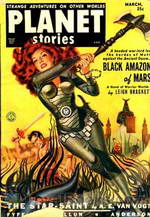 Asteroid of Fear
Asteroid of Fear
John Endlich needed to clean up his act. Gambling, drinking, a hot temper and wanderlust were the last things Rose and the kids needed. So he went to the Homesteaders Office and signed up to terraform Vesta, a chunk of a once thriving alien planet that had exploded from within; a flat lump of crust which was now the remains of a farm on one side and a mining operation on the other. The miners hated Endlich and sabotaged his plans at every opportunity. They were going to kill him and his family if he didn’t find a way to stop them. - Asteroid of Fear was first published in the March, 1951 edition of Planet Stories magazine. | |
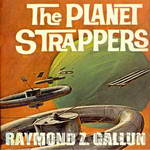 The Planet Strappers
The Planet Strappers
The Planet Strappers started out as The Bunch, a group of student-astronauts in the back room of a store in Jarviston, Minnesota. They wanted off Earth, and they begged, borrowed and built what they needed to make it. They got what they wanted--a start on the road to the stars--but no one brought up on Earth could have imagined what was waiting for them Out There! | |
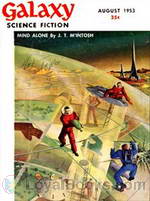 Stamped Caution
Stamped Caution
When an alien spacecraft crashes in Missouri a team of army investigators is dispatched. Among the debris they find a Martian infant and decide to raise him in their lab. Is he too strange to form a relationship with humans? Maybe, but he does have cute eye-stalks. – Stamped Caution was first published in the August 1953 issue of Galaxy magazine. | |
By: Richard Jefferies (1848-1887) | |
|---|---|
 After London, or Wild England
After London, or Wild England
First published in 1885, After London, or Wild England is considered to be one of the earliest instances of post-apocalyptic fiction, describing the effects of an unspecified catastrophe that dramatically changes the face of England and its population. Divided into two parts, the first depicts the fall of civilization, as society reverts to its more primitive roots, while the second part is set years after the apocalyptic event and examines the evident changes in both natural scenery and social structure... | |
By: Richard Mace Elam (1920-2013) | |
|---|---|
 Young Readers Science Fiction Stories
Young Readers Science Fiction Stories
This 1957 book contains thirteen pre-space-exploration stories for young readers. Some of the details show their dated composition but the sense of adventure will still hold attention for the young. - Summary by david wales | |
 Teen-Age Super Science Stories
Teen-Age Super Science Stories
Suspenseful stories about space travel and exploration of other planets. - Summary by TR Love | |
By: Richard Sabia | |
|---|---|
 I Was a Teen-Age Secret Weapon
I Was a Teen-Age Secret Weapon
Poor Dolliver Wims is a terribly misunderstood teen age boy from the backwoods. Is he mean or evil? Quite the opposite: He does nothing wrong, hurts no one and wants only to be liked and to help, yet he seems to be blamed for every accident that ever happens to anyone in the University research facility where he 'works' as a porter. Why does disaster seem to swirl around him like a tornado whips around it's eye. He never is hurt in the slightest way while others slash themselves with previously innocent knives, are smashed by falling bookcases that had no cause to fall, and are shot by guns that are safely tucked away... | |
By: Robert Bloch | |
|---|---|
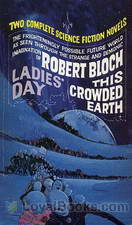 This Crowded Earth
This Crowded Earth
Robert Bloch was a prolific writer in many genres. As a young man he was encouraged by his mentor H. P. Lovecraft, and was a close friend of Stanley G. Weinbaum. Besides hundreds of short stories and novels he wrote a number of television and film scripts including several for the original Star Trek. In 1959 Bloch wrote the novel Psycho which Alfred Hitchcock adapted to film a year later. He received the Hugo Award, the World Fantasy Award, the Bram Stoker Award, and he is a past president of the Mystery Writers of America. Published in Amazing Stories in 1958, This Crowded Earth is a thriller set on an overpopulated Earth of the future. | |
By: Robert E. Howard (1906-1936) | |
|---|---|
 Shadows in Zamboula (version 2)
Shadows in Zamboula (version 2)
In the dark streets of Zamboula, huge ghouls stalk the night seeking victims for their ghastly rites and feasts. Conan is passing through this city and is almost a victim but escapes, only to rush to the aid of a beautiful, voluptuous maiden still in their horrible talons. Swords flash, thews are strained and the mighty Conan almost meets his match in the temple of the monkey god. Will he escape? Will he get the girl? Listen and marvel! Excellent story, well told as always by Howard. Summary by phil chenevert | |
By: Robert Emmett McDowell (1914-1975) | |
|---|---|
 Citadel of the Green Death
Citadel of the Green Death
At the coldly gleaming Experimental Station they flung this choice in Outlaw Joel Hakkyt's teeth: "Grinding, endless slavery on Asgard, that Alpha Centauri hell—or a writhing, screaming guinea-pig's death here?" He chose Asgard, naturally. But what was natural—on Asgard? - Summary by Robert Emmett Mcdowell | |
By: Robert F. Young (1915-1986) | |
|---|---|
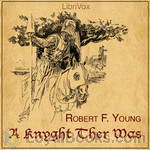 A Knyght Ther Was
A Knyght Ther Was
"But the Knyght was a little less than perfect, and his horse did not have a metabolism, and his 'castle' was much more mobile - timewise! - than it had any business being!" In 2178, once time travel had become a simple task, it had also been outlawed. Those who chose to ingnore this law were known as time-thieves, and Tom Mallory was among the best of them. When he learns the precise whereabouts of the Holy Grail in 542, he sets out to obtain it with the intention of returning it to the 22nd century to make a handsome profit and to settle on Get-Rich-Quick Street... | |
By: Robert Hugh Benson (1871-1914) | |
|---|---|
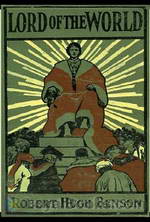 Lord of the World
Lord of the World
“Mr. Benson sees the world, four or five generations hence, free at last from all minor quarrels, and ranged against itself in two camps, Humanitarianism for those who believe in no divinity but that of man, Catholicism for those who believe in no divinity but that of God.” This apocalyptic novel from the early 1900's is sometimes deemed one of the first modern dystopias. | |
 Dawn of All
Dawn of All
In a former book, called "Lord of the World," I attempted to sketch the kind of developments a hundred years hence which, I thought, might reasonably be expected if the present lines of what is called "modern thought" were only prolonged far enough; and I was informed repeatedly that the effect of the book was exceedingly depressing and discouraging to optimistic Christians. In the present book I am attempting -- also in parable form -- not in the least to withdraw anything that I said in the former,... | |
By: Robert Moore Williams (1907-1977) | |
|---|---|
 Planet of the Gods
Planet of the Gods
Far, far in the future Earth has achieved real peace and is sending out interstellar expeditions, not to conquer, but to explore. The third such expedition, has made it to the Vega system and discovered to everyone's amazement, not only a solar system but two worlds circling the Vega sun that seem to have atmosphere and water. And apparently intelligent life is there as well as well because something tries, and almost succeeds, in blasting the expedition ship out of space before it can even get close to either one... | |
 Doomsday Eve
Doomsday Eve
In the midst of the war—that terrible conflict that threatened humanity's total destruction—the "new people" suddenly appeared. Quietly performing incredible deeds, vanishing at will, they were an enigma to both sides. Kurt Zen was an American intelligence officer among the many sent to root them out. He found them. Taken captive in their hidden lair, he waited as the enemy prepared to launch the super missile, the bomb to end all bombs—and all life. If only he could find the source of the new people's power, Kurt alone might be able to prevent obliteration of the Earth.... - Summary by Original text | |
 New Lamps
New Lamps
Ronson came to the Red Planet on the strangest mission of all ... he only knew he wanted to see Les Ro, but he didn't know exactly why. It was because he knew that Les Ro had the answer to something that had never been answered before, if indeed, it had ever been asked! For Les Ro traded new lamps for old—and they were the lamps of life itself! A story of what life holds for all of us. - Summary by Author | |
By: Robert Sheckley (1928-2005) | |
|---|---|
 The Status Civilization
The Status Civilization
Will Barrent awakes without memories just before being deposited on Omega, a planet for criminals where the average life expectancy is 3 years. He’s listed as a murderer and released into the illicit society as a “peon” the lowest class imaginable. A mysterious girl gives him a weapon that starts him on his path to status, a path that requires constant brutality. But it must be borne if our hero is to discover the reason for his imprisonment; A reason that pits him against himself, and involves the sardonically similar but devoutly different creeds of Omega and Earth... | |
 Watchbird
Watchbird
3 Robert Sheckley short stories that demonstrate the breathof his fantastic imagination. In Watchbird, the question "can machines solve human problems?" is answered with a resounding YES! But there may be a few unforeseen glitches. Just a few. Warrior Race drops us into an alien race of warriors who fight in a way you will never be able to imagine until you listen. And Beside Still Waters is a gentle story that shows us a man who really wants to get away from it all ... sitting on a rock in the asteroid belt with only a robot for a friend. No girls allowed! A poignant and unsettling story to say the least. | |
By: Robert Silverberg (1935-) | |
|---|---|
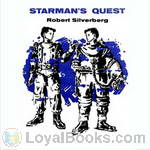 Starman's Quest
Starman's Quest
Travelling at speeds close to that of light, spacemen lived at an accelerated pace. When one of the twin boys left the starship, he grew older while his twin in space barely aged. So the starship twin left the ship to find what happened to his brother who was aging away on earth. | |
 Happy Unfortunate
Happy Unfortunate
Here are two early stories by the well known SF Author Robert Silverberg. The Happy Unfortunate was published first in Amazing Stories in 1957 and explores the angst caused when the human race reaches into space but at the cost of needing to breed a new species; specialized 'spacers' who can withstand the tremendous rigors of acceleration. The Hunted Heroes was published in Amazing stories a year earlier, in 1956. It is a futuristic story that holds great hope for the resilience of the human race after the war destroys most of the world. | |
 Master of Life and Death
Master of Life and Death
When Roy Walton becomes the new director of the UN division of population control, after the director is assassinated, he becomes the most hated man in the world. Being Director involved him in not only population control, but a terra-forming project on Venus, and negotiations with aliens. Not only that, but some people were trying to kill him. To stay alive, he had to become The Master of Life and Death. Summary by Dale Grothman. | |
By: Robert Silverberg and Randall Garrett (1935-) | |
|---|---|
 The Judas Valley
The Judas Valley
Why did everybody step off the ship in this strange valley and promptly drop dead? How could a well-equipped corps of tough spacemen become a field of rotting skeletons in this quiet world of peace and contentment? It was a mystery Peter and Sherri had to solve. If they could live long enough! [from the Judas Valley]Originally published in Amazing Stories, October 1956 | |
By: Samuel Butler (1835-1902) | |
|---|---|
 Erewhon
Erewhon
Erewhon, or Over the Range is a novel by Samuel Butler, published anonymously in 1872. The title is also the name of a country, supposedly discovered by the protagonist. In the novel, it is not revealed in which part of the world Erewhon is, but it is clear that it is a fictional country. Butler meant the title to be read as the word Nowhere backwards, even though the letters “h” and “w” are transposed. It is likely that he did this to protect himself from accusations of being unpatriotic, although Erewhon is obviously a satire of Victorian society. | |